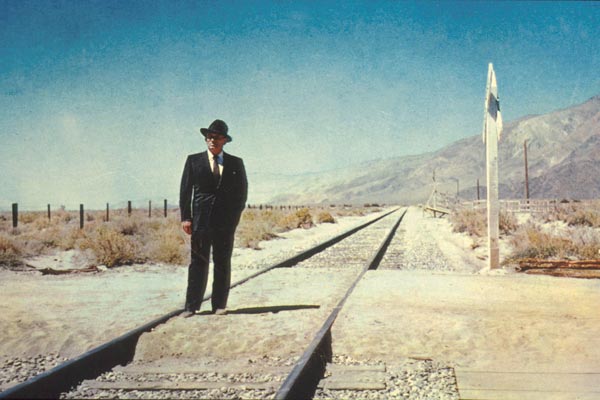Bad Day at Black Rock (John Sturges,1955): USA
Reviewed by Collier Grimm. Viewed on DVD.
 I’m a big fan of the Western. I’m also a big fan of Film Noir. However, it’s hard to picture a picture that can mix the American splendor of a Western with the cynicism and pessimism of good Noir. Amazingly, however, John Sturges does just that in his 1955 classic, Bad Day at Black Rock. The film reflects the uneasy sentiments of post-war America; filmsite.org reveals, “It can also be seen as a powerful, allegorical indictment of the Hollywood blacklist, created during the climate of suspicion and fear of the 1950s McCarthy era.” Bad Day at Black Rock develops a social commentary on problems of the time and becomes the ultimate revision of two classically American genres.
I’m a big fan of the Western. I’m also a big fan of Film Noir. However, it’s hard to picture a picture that can mix the American splendor of a Western with the cynicism and pessimism of good Noir. Amazingly, however, John Sturges does just that in his 1955 classic, Bad Day at Black Rock. The film reflects the uneasy sentiments of post-war America; filmsite.org reveals, “It can also be seen as a powerful, allegorical indictment of the Hollywood blacklist, created during the climate of suspicion and fear of the 1950s McCarthy era.” Bad Day at Black Rock develops a social commentary on problems of the time and becomes the ultimate revision of two classically American genres.
Bad Day at Black Rock boasts a plot full of deception, darkness, and mystery intertwined with long shots of the great American landscape as well as iconic Western archetypes and iconography. The film is less certain in its Western values, but takes place in a conventional Western town where the Southern Pacific train has not stopped in four years. The set looks familiar–one saloon, one hotel, and boardwalk in tow–and the repetitive long shots of the rail road tracks that stretch into the distance pay homage to Fred Zinneman’s, High Noon. Like many revisionist Westerns, “Bad Day” is emotionally and intellectually stimulating, and much more stylistically complex than your average “shoot ‘em up” cowboy picture.
The film is also a revision on the typical lighting and imagery associated with Film Noir. Hidden within the high-key lighting and typically Western looking landscape is a web of lies spun through the dark and secret lives of the people of Black Rock, Arizona. Tracy is hidden behind the shadows of his hat, and his character, John J. Macreedy, remains a mystery throughout most of the film. The environment in which these characters interact creates a hopeless mood. Their insignificance within nature not only revisits the Western, but reflects 1950s sentiments about the looming threat of the Cold War. The camera is often so stagnant that the production could be turned into a stage play. The compositional tension of each shot works to create uneasiness and a sense of entrapment on and off the screen. As the characters fall deeper into deception and mystery, you may find yourself squirming in discomfort.
As soon as John J. Macreedy, an injured war veteran, steps off the train in Black Rock he is met with hostility from all the people he encounters. Macreedy says that he is looking for a man named Kokomo, but it appears Kokomo has moved and no one is sure of his current whereabouts. We watch as Macreedy is met with ferocity from all the residents of Black Rock and is warned to leave town immediately. Do the townspeople suspect Macreedy has had something to do with Kokomo’s disappearance, or are they hiding a secret? What exactly is Macreedy’s business with this Kokomo character? Will Macreedy be run out of town? Who is in the right, and who is in the wrong here anyway?
I’m not going to give any more of the plot away; I read the synopsis on my Netflix disc before viewing and it revealed many things I would have liked to have been kept in the dark about. Everyone in this film is a mystery, and they all appear to have ill intentions toward one another. Only through the unraveling of the Film Noir-like plot can one begin to make conclusions about the truth. The mysterious supporting cast is full of classic film favorites: Robert Ryan, Lee Marvin, Ernest Borgnine, and Walter Brennan, who each add complexity and talent to the film.
Bad Day at Black Rock is sure to surprise and hopefully inspire. It is a wonderful revisionist Wester , and I love every moment that Tracy is on screen. His edginess is startling and refreshing in a genre typically filled with stuffed–shirt cowboys. I highly recommend this film, and consider it one of the best classic films I’ve seen this year.
1 Comment
Jump to comment form | comments rss [?] | trackback uri [?]